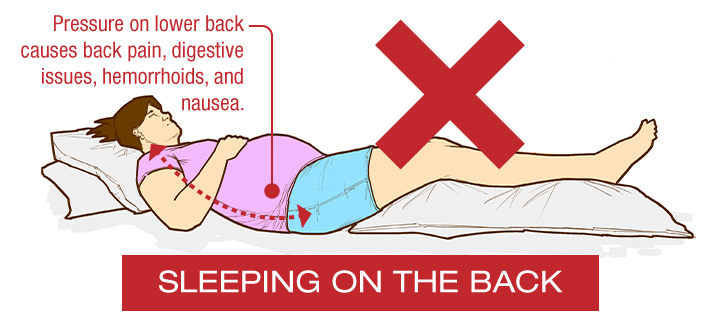When you’re in any stage of pregnancy, sleep poses a difficult problem: you need more rest for both yourself and your developing baby, but the changes your body undergoes as your pregnancy furthers can make it difficult to fall and stay asleep. Finding a position that’s safe and still comfortable can be challenging because the additional weight seems to make any way you lie down stressful on your body. But there is a solution, and it’s important for your health that you use it.
What is the safest sleep position during each trimester? The answer is the same for each stage of pregnancy: sleeping on your left side. However, other positions can be used during different trimesters comfortably. In this article, we’ll dig into each one and explain when they’re best, when they’re safe, and when they’re potentially dangerous.
What Is A Sleep Position?
The science behind sleep positions is based on supporting your body’s natural spinal alignment. Factors like your weight, pillow density, and mattress softness play roles in determining how well your spine stays aligned throughout the night. When your body isn’t properly aligned, you’ll feel it throughout your back, shoulders, and neck.
 Ultimately, to sleep comfortably, we choose a sleep position that’s best suited for our body type, bed, and pillows. This can be distilled down to three primary positions: side, back, or stomach. Each one works to support different points of your body to try and keep your neck and spine in a neutral position.
Ultimately, to sleep comfortably, we choose a sleep position that’s best suited for our body type, bed, and pillows. This can be distilled down to three primary positions: side, back, or stomach. Each one works to support different points of your body to try and keep your neck and spine in a neutral position.
When you’re pregnant, you can still sleep in any of these three positions, but how they support and stress your body changes significantly. Of particular concern are your stomach and spine, both of which may need additional protection to support a healthy; developing baby. Thankfully, balancing spinal alignment with the additional weight of pregnancy doesn’t have to be difficult.
Side Sleeping
Sleeping on your side is safest for both you and your baby. The weight of your abdomen won’t be pushing back on your spine, and by putting some of that weight directly on your mattress you’ll feel less uncomfortable throughout the night. Most people are naturally side sleepers, but if you’re someone who prefers to sleep on your back or stomach it’s easy to adapt to.
Normally, it doesn’t matter which side you sleep on to achieve a good night’s sleep. But when you’re pregnant, there is a difference between left and right. Your left side is considered the better of the two choices because it allows for blood to more easily circulate to your placenta.

Besides that, sleeping on your right side isn’t thought to be dangerous during pregnancy. A few studies have been conducted alleging that there are additional benefits for sleeping on the left side, but they’re not conclusive. The left side is recommended simply for improved blood flow.
Stomach Sleeping
You may have heard that sleeping on your stomach while pregnant should be avoided, and the idea makes sense on paper. After all, doing so would apply additional weight directly onto your abdomen. However, stomach sleeping is warned against not for safety reasons but for the sake of comfort.

The walls of your uterus are incredibly strong and during the early months of pregnancy, you can sleep face down without fear if that’s what you’re comfortable with. If it weren’t for how much your stomach grows in the later stages; you could probably continue sleeping that way without worry. While it’s not as ideal as sleeping on your left side, stomach sleeping is perfectly fine. However, by the time you reach the third trimester the size of your belly makes it difficult to rest comfortably on your stomach.
Back Sleeping
If you find that you sleep easiest on your back, you’re unfortunately out of luck: while it may not feel too uncomfortable during the first trimester, it will become painful after that, so physicians warn against it. The problems you experience when you’re pregnant—things like back pain, digestive issues, hemorrhoids, and nausea—can be worsened when you sleep on your back. When you’re in that position, your midsection presses down on your intestines. The physical pain caused by this will worsen the longer you’re on your back.

There are more dire health complications that can arise when sleeping in this position while you are pregnant. You may experience low blood pressure and weakened circulation to your baby and your own heart. Because of these issues, it’s considered the most dangerous sleep position for you and your baby’s health during any stage of pregnancy.
What If I Move During the Night?
If you’re like most people, you don’t fall asleep in one position and stick to it throughout the night. Whether you regularly toss and turn or gradually find yourself turning over for the sake of comfort; it’s only natural to move about when you’re sleeping. You may not have thought about it much before your pregnancy. But with the new importance of proper sleep positions, you might be wondering what you do if you wake up on your stomach or back.
The thing to keep in mind is this: while these positions can be harmful over prolonged periods, they aren’t immediately harmful to you or your baby for short periods of time. Moreover, you’ll be forced awake by the discomfort you feel well before your baby is at serious risk. So if you wake up, simply return to your preferred position before falling back asleep.
Getting Comfortable in A New Sleep Position
It can be hard to break a sleep habit, even as the changes in your body demand it. To better help adjust to a new sleep position, or to augment one to benefit your pregnancy; there’s a handful of tricks you at your disposal that is both simple and doctor approved. Each of these focuses on maintaining good neck, shoulder, and spinal alignment while supporting the weight of your abdomen in a way that takes the pressure off of other parts of your body.
The simplest pregnancy aids you can use are pillows. The pillows you already have can be used to relieve pressure from different points in your body. Depending on how you sleep, there are a variety of specially-shaped pillows to compliment your body’s changing contours.
Best position
Though sleeping on your left side is by far the best position when your pregnant, you may still experience lower back and joint pain after the first trimester. This is where your standard pillows can be the most useful. Try sleeping with one placed between your thighs or bent knees can take the edge off of joint pain. If lower back pain is an issue for you in this position, rest with a thin to middle thickness pillow underneath your stomach to take some of the extra pressure off.
If you have a full-length body pillow (or don’t mind investing in one—they aren’t very expensive), you can use that instead to achieve the same effects. Sleep with your right arm and leg wrapped around it to keep your back aligned with your neck. You may still need a pillow beneath your abdomen, though.
 The unique angle and lift of wedge pillows are great if you’re experiencing heartburn, indigestion, or an upset stomach, or if you sleep on your back. You rest against it so that your head is just beneath the uppermost edge of the wedge (its low point should reach your lower back). Wedge pillows tend to be bulky, however, and because they’re made of foam you can’t adjust their softness or density. If they don’t appeal to you, you can just as easily pile up regular pillows into a wedge.
The unique angle and lift of wedge pillows are great if you’re experiencing heartburn, indigestion, or an upset stomach, or if you sleep on your back. You rest against it so that your head is just beneath the uppermost edge of the wedge (its low point should reach your lower back). Wedge pillows tend to be bulky, however, and because they’re made of foam you can’t adjust their softness or density. If they don’t appeal to you, you can just as easily pile up regular pillows into a wedge.
Finally, if you prefer to sleep on your back but don’t enjoy wedge pillows; your next option should be a nice, soft recliner. When fully reclined you’ll still feel elevated (more so than with a wedge pillow, in fact); but the way you’re legs get lifted relieve a greater number of pressure points throughout your body.
A Word About Pillows
A cursory glance at online stores will tell you that there are many different types of pregnancy pillows on the market. These allege to help you sleep better by supporting your body in unique ways. To this end, they come in all different sorts of shapes and make use of every filling you can think of.
While it seems like a sound idea, it’s difficult to recognize how effective they are, let alone recommend them, simply because there are so many available. It gets particularly murky with pillows that are shaped to support your abdomen in various positions. Because they aren’t making very specific medical claims, there isn’t a governing body testing how effective they are, so buyer beware.
When it comes to pillows and pregnancy, you can keep things simple by listening to what your body tells you. If any part of your body feels strained when you wake up, take it as a sign that you need more support in that area.
How Much Should I Sleep During Pregnancy?
The amount of sleep you need when you pregnant is different than what you’d normally aim for otherwise. You’ll be resting more, and the extra sleep is necessary for your body to regulate the different functions that help your baby develop during pregnancy. The general rule of thumb is that there’s no such thing as too much sleep when you’re expecting.
This is especially true during the first trimester. Your body is producing higher levels of progesterone, a hormone that makes you feel drowsy and tells your brain it’s time for sleep. During early pregnancy, this means taking daytime naps. Embrace it – it’s necessary to keep yourself energized.
By contrast, the third trimester is when a majority of women get less sleep (or experience sleep of a worsening quality). By now the baby has grown so much that it’s pressing on your bladder; sending you out for frequent bathroom trips. You’re likely to experience sleep disturbances like heartburn and leg cramps. It’s important to keep track of these symptoms and discuss them regularly with your doctor.
I’m Still Having Trouble Sleeping
If you’re still finding it hard to sleep on your left side during pregnancy, or if you’re having trouble sleeping in the third trimester in general; here are some easy tips to help you out:
Don’t turn to sleep medications
Unless you are explicitly directed to use sleep aids by your primary care physician, they should be avoided entirely. They could have unintended consequences for your baby.
Do stretches and go walking regularly

This will help curb leg pains and combat restlessness. While it’s a good idea to stay active while pregnant, this doesn’t mean you need to perform strenuous activity. A few minutes of stretching a day may be all you need (the closer to bedtime, the better).
Sleep with your arms crossed over your chest
One of the problems people face when they try to make the change to sleeping on their side is what to do with their arms. Sleeping on your left arm, or with that arm under a pillow, can cause pain and circulation problems. If you cross them in front of your chest before you fall asleep odds are better that you’ll avoid this problem.
Stabilize yourself with pillows in the front and back
If you feel a little uneven or insecure while you’re sleeping on your side, you can place a body pillow in front of or behind you (or both) to decrease the amount you move while you sleep.
Add a layer of foam to your mattress
If you’re used to sleeping on a spring coil mattress, the firmness of it may become uncomfortable while you’re pregnant. Rather than replace it, try adding a layer of foam to soften it. The extra layer will easily mold to your contours while minimizing the pressure the individual coils can make. It can also help cradle you, similar to the above tip.
You don’t want to take any risks when you’re pregnant, even with your sleep. Keep things safe for you and your baby’s well being.






